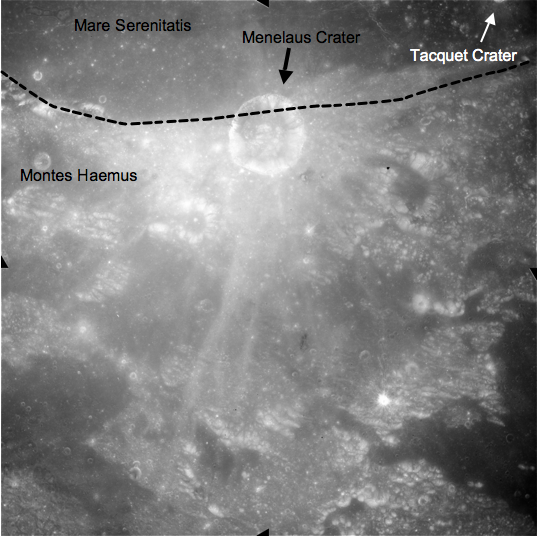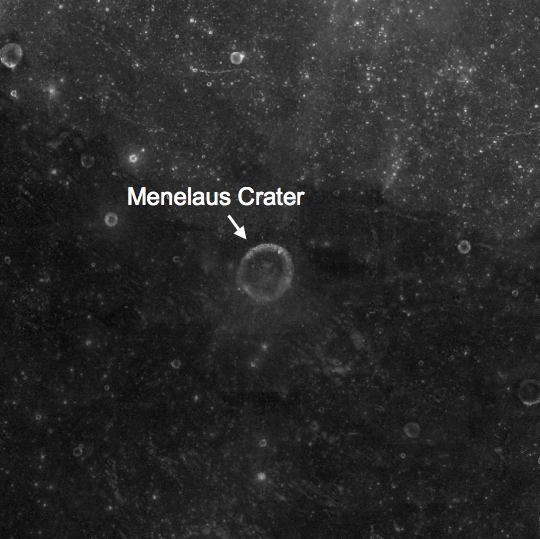
| Project Home | About the Scans | Browse Gallery | Image Map | Support Data | Resources | Ephemeris |
Featured Image - 01/13/2009
Menelaus' Distinctive Rays
Menelaus crater (27 km in diameter, Figure 1) straddles the highlands-mare boundary at the southwestern margin of Mare Serenitatis. Menelaus has bright interior walls and central peaks (Figure 2). At first glance, the interior of Menelaus catches your eye because the northern part of the crater appears slightly darker than the southern portion. Compositionally, this difference in albedo may indicate the excavation of darker mare material to the north, and brighter highlands material to the south.

Figure 1. Menelaus crater, located at approximately 16.3 ° N, 16.0 ° E. The bright interior of the crater is visible, and the broad ray pattern is distinctive at this high sun angle (~73 °). To the right (east) of this image is Tacquet crater. The dashed line traces the highlands-mare boundary. (Apollo Metric frame AS15-M-2433 [NASA/JSC/Arizona State University])
A second glance reveals Menelaus' distinctive ray pattern. Three bright, large, broadly diffuse rays extend from the crater toward the east, south, and west, while a less distinguished, subdued ray extends toward the north onto Mare Serenitatis (Figure 1, 2). Small rays superposing Mare Serenitatis are also visible to the east. Generally, the presence of a distinct ray pattern suggests that Menelaus is a relatively young impact crater. However, in an optical maturity map derived from Clementine data (Figure 3) these rays are barely visible, suggesting near-maturity. If the material composing the crater rays is nearly mature, then why are the rays visibly bright? If this is the case, then a plausible explanation is that the albedo variations between the rays and the surrounding surface materials are a result of compositional differences. These compositional differences are a result of the excavated, less-mature, higher albedo highlands material from the crater overlying the surrounding materials, which are lower albedo and more mature.
Figure 2. Apollo 15 70 mm Hasselblad photograph acquired from the orbiting command module. This oblique view of Menelaus crater (27 km diameter) clearly shows the highland-mare boundary as well as the bright ejecta deposits and terraced walls of the crater. (Apollo frame AS15-90-12294 [Lunar and Planetary Institute/Universities Space Research Association])
Figure 3. Optical maturity map of Menelaus crater, derived from Clementine multispectral data. Dark areas are mature (older) and bright areas are immature (younger). Note that the bright rays observed in Figure 1 are not observed in this image indicating the rays are compositional in origin, rather than maturity. [Clementine image USGS/NASA]

|
|
Space Exploration Resources |
|
 LPI LPI
|

